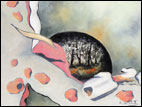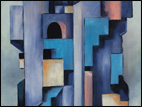 |
 |
 |
| CRITIQUES AND COMMENTARIES OF THE WORK AND THE EXHIBITIONS |
page: 2/4
|
 |
 |
 |
 |
(...) Another important paragraph to bear in mind of Carmucha's work is the quality and the freshness of her landscapes, since it is one of the genres
in dumb of which the painter carries out a skilful manipulation of her pictorial resources and the major one of her technical possibilities. In the
landscapes of Carmucha fluctuates diverse trends that go from bucolic, nice, that she recreates in the pictures of genre, bot, fund of her rural
scenes, passing for these landscapes that for yes alone constitute the subject matter of the picture and in which the painter, with a great skill in
the technology send us in touching atmospheres that leak out "galleguidad" and in near visible paces that sublie also in other landscapes foreign to
the Galician subject matter. Finally, the artist will come to the construction of a few landscapes in which she resigns her proper style for achieving
a vision mas abstract, obtaining innovations that break with the traditional thing and facing this way the challenge of looking in these occasions for
a new identity without resigning her sense of perceiving the abstraction.
The whole Carmucha's work offers inside a subtle balance between tradition and modernity, so it contains important lessons of experience fruit
of a dialog between the past, with an own language supported by a successful balance among the light and the color, for a few poetical values and for
a merger of genres without stridencies. For all that the visual impact of her work is big because she has a great power of narrative persuasion,
which facilitates in an admirable way, the capacity of dialog with the spectator, owed largely to the brightness and precision that awards him to her
works and also because they are fabrics impregnated with references, of taken root autochthonous.
MERCEDES GALLEGO ESPERANZA
Doctor of History of the Art |
 |
 |
From her first exhibition, in a distant March she does (...), vigorous this one and still new painter us comes giving samples of an artistic language
in which predominates, first of all, over the importance of the memory,the recollections, the customs: this way in her great linen on the medieval
bridge - symbol of our city, and present in the providential heraldry since very well there knows this painter of heraldic affections-, (...) she
recreates us an space well acquaintance in several times, in an epoch in which Beautiful Sight or it was, without any doubt. The interior life, the
fantasy, the imagination, the dream.
Longing for living, if, but feeling homesickness of the unattainable thing. A time in which the children were going to the rural school and
the mothers were seeing off them under the umbrellas, in the surrounding areas. It is as well as these children go from their mothers up to the
teacher, who will bring them over to a new world, Carmucha's painting comes from her thin spatulas managed with mastery, up to us (...) coming closer
with fascination the past, which across her power of creation took form in this exhibition.
FRANCISCO XAVIER LIMIA GARDÓN
Historian and art critic |
 |
 |
Not with the meticulous and austere vision of the critic, but with the intuition of the poet, who can catch the beauty there where it demonstrates to
the contemplative eyes, we visit the exhibition that, (...) Vázquez Parts and our pupils took delight with the delicate shades of her oils, in her soft
tonalities, which go from the ranges of gray (her favorite ones), to the withered golden of Galician October, the blue ténues of the river and of the
sky, in chromatic succession of exquisite qualities. Her feminine, intuitive soul, with romantic fund, orchestrated in Chopin's harmonies, admiradora
of the Greek one or of Goya, is projected in a classic, pure and pristine direction, which alternates with essays of French impresionism.
JACOBO I. REY PORTO
Poet |
|
 |
|  |
|
 |
 |









